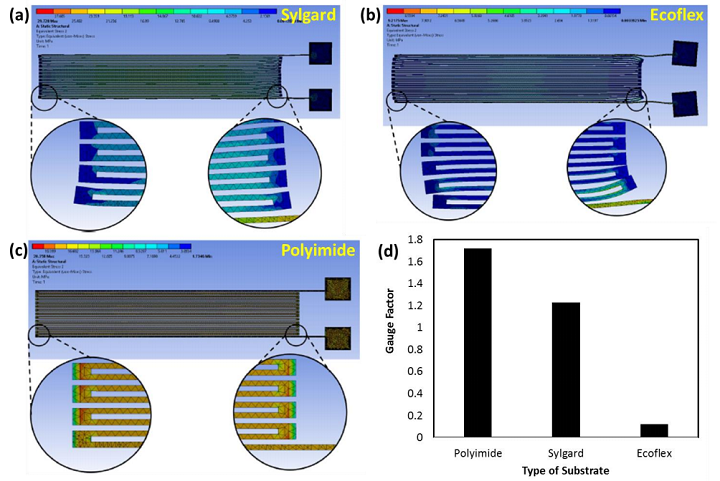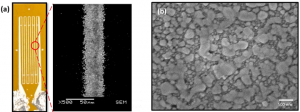Adjusting the Design, Material, and Parameters of a 3D Printed Strain Gauge with Computational Simulation
A trio of researchers from the
The abstract reads, “Three-dimensional (3D) printing has been gaining widespread attention for electronic applications. Aerosol jet printing has emerged as a powerful technique to print new-age sensors and devices on various substrates. In this work, we use simulation studies to optimize the dimensions and design of aerosol jet printed strain sensor for good performance. Physical dimensions like the end loop length, number of grids, grid line width, gauge length, and five different sensor designs are simulated to study their effect on the performance of the strain sensor. The study helps to identify the factors that affect the sensitivity and gauge factor of the flexible strain sensor fabricated using aerosol jet printing technology.”
Strain gauges are simple devices that measure the strain, or pull, on an object. The resistance of an object changes as deformation is applied to the strain gauge, which will then reveal how much deformation the object is currently undergoing. While traditionally these devices have many lengthy steps involved in their fabrication, such as bonding, curing, etching, and trimming, 3D printing is starting to be more widely used in the manufacturing of strain gauges.
Aerosol jet 3D printing, or aerosol jetting, is a mask-less, non-contact way to 3D print electronic inks with high resolution, and has been used to manufacture strain gauges out of materials like carbon nanotubes, silver, and various structures and substrates. But as the technology continues to advance, it’s more important than ever to perfect the design and analysis of stress and measurement of the strain.
“This work uses 3D printing technology of aerosol jet to fabricate strain gauge on various substrates. The motivation is to understand the design requirements,” the researchers explained. “Computational simulations are carried out to study the effect of various parameters and design patterns on the overall performance of the fabricated sensor. The study helps to evaluate how different design parameters affect the sensor performance, thus identifying the essential ones for fabricating a sensitive device.”
The team used SOLIDWORKS to design a prototype strain gauge out of Clariant silver nanoparticle ink, and then simulated its performance with ANSYS Workbench R18.1, conducting static structure and electric analysis during the simulation. They performed stress analysis on three different types of substrates – Sylgard, Ecoflex, and Polyimide – during the simulation. All of the substrates were “deformed in the direction of the grid.”
The grid design affects the device’s sensitivity and gauge factor, and the researchers experimented with five different designs in this study: square wave, zigzag wave, sinuous wave, connected end loop, and 3D grid.

Stress analysis on the grid for strain sensor on various substrates, namely (a) Sylgard, (b) Ecoflex, and (c) Polyimide. (d) Column chart depicting the gauge factor values computed for the strain sensor on different substrates.
“Strain gauges use metallic conductors that undergo change in electrical resistance, and this change is recorded as the gauge factor (GF),” the researchers wrote. “Technically, gauge factor can be defined as the ratio of the fractional change in resistance to the fractional change in length (strain) along the axis of the gauge device. Although strain sensor’s gauge factor is a crucial factor that determines its performance, there are various other parameters that can affect a sensor’s performance. Careful selection of the parameters is important as it affects the performance especially the sensitivity of the sensor.”

(a) Optical image of the aerosol jet 3D printed strain gauge, (b) FESEM image of the silver nanoparticle film after sintering.
When comparing the stress distribution of the foils on different substrates, the researchers saw that it was less uniform throughout the grid lines for the two softer materials, but more uniform for the polyimide, which is not stretchable. This leads to better stress distribution on the foils, as well as the lines deforming uniformly once load is applied, resulting in a higher change in resistance of the grid and ultimately a higher GF.
In addition to saving time and money, the simulation studies, which were “corroborated through experimental results,” helped the researchers evaluate different parameters of the strain sensor. Results indicate that computational simulation can be used to enhance a strain sensor made with aerosol jetting.
“It was deduced that substrates with high Young’s modulus will render more sensitivity to the performance of the sensor. Heightened sensitivity can be achieved when the mechanical properties of the foil grid and substrate are comparable. Different foil grid designs were studied for strain gauge performance,” the researchers concluded. “The study further investigated the effect of various dimensions on the strain sensor gauge factor. The optimized parameters were found to be 3 for ratio of end loop length to grid width, 20 μm for the width of the grid lines and 5 mm for the gauge length with 26 grid lines. The parameters obtained using simulation studies were used to fabricate a working model of the sensor using silver conducting ink on polyimide substrate. The optimized strain gauge is measured to have a gauge factor of 9-10 with silver nanoparticle film for the grid.”
Discuss this research and other 3D printing topics at 3DPrintBoard.com or share your thoughts below.
Subscribe to Our Email Newsletter
Stay up-to-date on all the latest news from the 3D printing industry and receive information and offers from third party vendors.
You May Also Like
3D Printing News Briefs, April 13, 2024: Robotics, Orthotics, & Hypersonics
In 3D Printing News Briefs today, we’re focusing first on robotics, as Carnegie Mellon University’s new Robotics Innovation Center will house several community outreach programs, and Ugogo3D is now working...
Rail Giant Alstom Saves $15M with 3D Printing Automation Software 3D Spark
3D Spark has entered into a three-year deal with the rail giant Alstom. Alstom, a transport behemoth with annual revenues of $16 billion, specializes in the manufacture of trains, trams,...
Meltio Expands Global Reach with New Partnerships in the Americas and Europe
Spanish 3D printing manufacturer Meltio has expanded its sales network across the globe. With the addition of three new partners in the United States, Brazil, Argentina, and Italy, Meltio aims...
3D Printing Webinar and Event Roundup: April 7, 2024
Webinars and events in the 3D printing industry are picking back up this week! Sea-Air-Space is coming to Maryland, and SAE International is sponsoring a 3D Systems webinar about 3D...

































